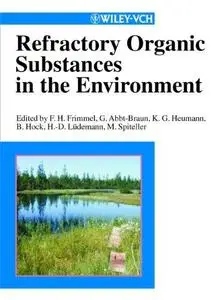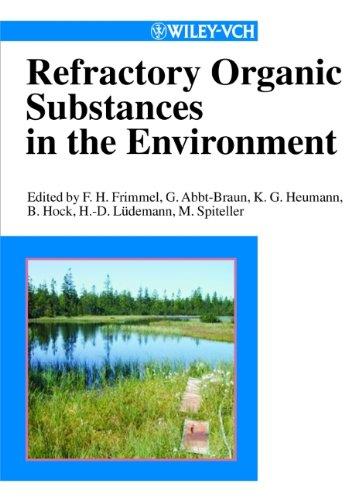Refractory Organic Substances in the Environment By
2002 | 576 Pages | ISBN: 3527301739 | PDF | 10 MB
2002 | 576 Pages | ISBN: 3527301739 | PDF | 10 MB
Refractory organic substances (ROS) are an essential part of the biogeochemical carbon cycle. Wherever there is life on earth, there will also be ROS in the form of poorly biodegradable leftovers of organisms and as a source for new life. Furthermore, it is now beyond doubt that ROS are closely related to the carbon intensity identified as one of the driving forces in the dynamics of green house gas emission, such that ROS play a key role in sustainable development. Refractory Organic Substances in the Environment provides the results of six years of top-priority research, funded by the Deutsche Forschungsgemeinschaft (DFG). This research program investigated the structure and function of ROS in different parts of the environment, from a chemical, physical, biological, and soil scientific point of view. It included the first systematic study of a set of reference samples from Central Europe, originating from a bog lake, soil seepage water, groundwater, and from the wastewaters of a brown coal processing plant and a secondary effluent. Thus, this work not only highlights the structural features obtained from the application of advanced analytical tools, but also the function in anthropogenically influenced aquatic systems and soils. Of special interest to students and researchers in life sciences. Content: Chapter 1 Setting the Scene: The Relevance of Reference Materials ? Isolation and General Characterization (pages 1–38): Dr. G. Abbt?Braun and Prof. Dr. F. H. FrimmelChapter 1 Setting the Scene: Element Determination and its Quality Control in Fractions of Refractory Organic Substances and the Corresponding Original Water Samples (pages 39–53): Prof. Dr. K. G. Heumann, Dr. G. Abbt?Braun, K. Behrens, Dr. P. Burba, Prof. Dr. F. H. Frimmel, Dr. B. Jakubowski, Professor A. Knochel, Dr. J. Mielcke, Dr. G. Radlinger, Dr. G. Marx and Dr. J. VoglChapter 2 Structural Investigations: Heavy Metal and Halogen Interactions with Fractions of Refractory Organic Substances Separated by Size?exclusion Chromatography (pages 55–72): Prof. Dr. K. G. Heumann, Dr. G. Marx, Dr. G. Radlinger and Dr. J. VoglChapter 2 Structural Investigations: Characterization of Refractory Organic Substances and their Metal Species by Combined Analytical Procedures (pages 73–88): Dr. P. Burba, Dr. B. Jakubowski and J. Van den BerghChapter 2 Structural Investigations: Application of Nuclear Magnetic Resonance Spectroscopy to Structural Investigations of Refractory Organic Substances – Principles and Definitions (pages 89–95): Dr. J. Lambert and Dr. U. LankesChapter 2 Structural Investigations: Structural Characterization of Refractory Organic Substances by Solid?state High?resolution 13C and 15N Nuclear Magnetic Resonance (pages 96–114): Dr. U. Lankes and Professor H.?D. LudemannChapter 2 Structural Investigations: Quantification of Substructures of Refractory Organic Substances by Means of Nuclear Magnetic Resonance (pages 115–128): Dr. S. Haiber, H. Herzog, Professor J. Buddrus, Dr. P. Burba and Dr. J. LambertChapter 2 Structural Investigations: Nuclear Magnetic Resonance Spectroscopy Investigations of Silylated Refractory Organic Substances (pages 129–145): Dr. N. Hertkorn, Dr. A. Gunzl, Dr. D. Freitag and Professor A. KettrupChapter 2 Structural Investigations: Isotopic Evidence for the Origin and Formation of Refractory Organic Substances (pages 146–162): Dr. G. Gleixner, Dr. O. Kracht, Dr. H.?L. Schmidt and Dr. E.?D. SchulzeChapter 2 Structural Investigations: Analytical Pyrolysis of Humic Substances and Dissolved Organic Matter in Water (pages 163–187): Professor H.?R. Schulten, Professor P. Leinweber and Dr. G. JandlChapter 2 Structural Investigations: Characterization of Refractory Organic Substances by HPLC/MS (pages 188–199): Professor M. Spiteller, Dr. U. Klaus and Dr. T. PfeiferChapter 2 Structural Investigations: UV?Visible Spectroscopy and the Potential of Fluorescent Probes (pages 200–214): Professor H. LanghalsChapter 2 Structural Investigations: Stationary and Time?resolved Fluorescence for Refractory Organic Substances Characterization (pages 215–231): Dr. M. U. Kumke and Prof. Dr. F. H. FrimmelChapter 2 Structural Investigations: Structural Characterization of Refractory Organic Substances by Pyrolysis?GC/FTIR (pages 232–238): Dr. A. N. Davies, Dr. W. Hill and Dipl.?Ing. R. KuckukChapter 2 Structural Investigations: X?Ray Microscopy Studies of Refractory Organic Substances (pages 239–248): Dr. J. Thieme, Dr. C. Schmidt, Dr. G. Abbt?Braun, C. Specht and Prof. Dr. F. H. FrimmelChapter 2 Structural Investigations: Fractionation of Refractory Organic Substances by Electrophoresis (pages 249–263): Dr. H. H. Ruttinger and Dr. R. DunkelChapter 2 Structural Investigations: Occurrence of Amino Acids, Carbohydrates, and Low?Molecular?weight Organic Acids in Refractory Organic Substances (pages 264–281): Dr. J. B. Jahnel, T. Brinkmann, Dr. G. Abbt?Braun and Prof. Dr. F. H. FrimmelChapter 2 Structural Investigations: Serological Characterization of Refractory Organic Substances by Serotyping (pages 282–301): Dr. R. Muller?Starck, M. Kania, Dr. A. Dankwardt and Professor B. HockChapter 2 Structural Investigations: Chemical and Spectroscopic Data of the Reference Samples – Comparison and Evaluation (pages 302–309): Dr. G. Abbt?Braun, Dr. U. Lankes, Dr. J. B. Jahnel, Dr. J. Lambert, Professor H.?D. Ludemann and Prof. Dr. F. H. FrimmelChapter 3 Biochemical and Biological Characterization: Formation, Utilization, and Transformation of Some Refractory Organic Substances by Aquatic Microorganisms (pages 311–320): Professor Z. Filip and Dr. H. ClausChapter 3 Biochemical and Biological Characterization: Effect of Microorganisms on the Formation and Transformation of Iodine Species of Refractory Organic Substances (pages 321–329): Professor K. G. Heumann, Dr. G. Radlinger, Dr. H. Claus, Professor Z. Filip, M. Erbes, I. Heiber and PD Dr. U. ObstChapter 3 Biochemical and Biological Characterization: The Influence of Refractory Organic Substances on Bacterial Colonization and Diversity Patterns (pages 330–345): Dr. T. Koch, S. Honschopp, O. Janssen?Weets and Professor A. NehrkornChapter 3 Biochemical and Biological Characterization: Influence of Refractory Organic Substances on Enzyme Activity in?vivo and DNA Damage of Aquatic Microorganisms (pages 346–360): I. Heiber, Dr. M. Wiegand?Rosinus, M. Erbes and PD Dr. U. ObstChapter 3 Biochemical and Biological Characterization: Effects of Dissolved Organic Matter on the Bioconcentration of Organic Contaminants and on Reproduction in Aquatic Invertebrates (pages 361–381): Dr. M. Haitzer, Dr. S. Hoss, Professor W. Traunspurger, Professor J. Kukkonen, Dr. B. K. Burnison and Professor C. E. W. SteinbergChapter 4 Molecular Interactions: Sorption of Dissolved Organic Matter on Soil Particles and its Dependence on their Surface?charge Properties (pages 383–393): Professor W. R. Fischer and Dr. F. ButtchereitChapter 4 Molecular Interactions: Dissolved Organic Carbon in Seepage Water – Production and Transformation During Soil Passage (pages 394–410): PD Dr. B. Ludwig, Dr. B. Heil, H. Flessa and Professor F. BeeseChapter 4 Molecular Interactions: Refractory Organic Substances in Aggregated Forest Soils – Retention versus Translocation (pages 411–434): Dr. K. Kaiser, PD Dr. G. Guggenberger, Professor M. Kaupenjohann and Professor W. ZechChapter 4 Molecular Interactions: Refractory Organic Substances Derived from Organic Amendments in Soil – Formation, Translocation, and Interaction with Xenobiotics (pages 435–445): Dr. Th. Putz, Professor F. Fuhr and S. BrandtChapter 4e Molecular Interactions: Analysis of the Binding of Amitrole and Anilazine to Aquatic and Terrestrial Refractory Organic Substances (pages 446–474): Professor M. Spiteller, Dr. U. Klaus and Dr. T. PfeiferChapter 4 Molecular Interactions: Sorption and Chemical Reactions of Polycyclic Aromatic Hydrocarbons with Dissolved Refractory Organic Substances and Related Model Polymers (pages 475–515): Professor F.?D. Kopinke, Dr. A. Georgi, Dr. K. Mackenzie and Dr. M. U. KumkeChapter 4 Molecular Interactions: Investigation of the Interactions between Polycyclic Aromatic Compounds and Refractory Organic Substances with Stationary and Time?Resolved Fluorescence and Absorption Spectroscopy (pages 516–534): Professor H.?G. Lohmannsroben, Dr. U. Schultze and Dr. T. Skrivanek



